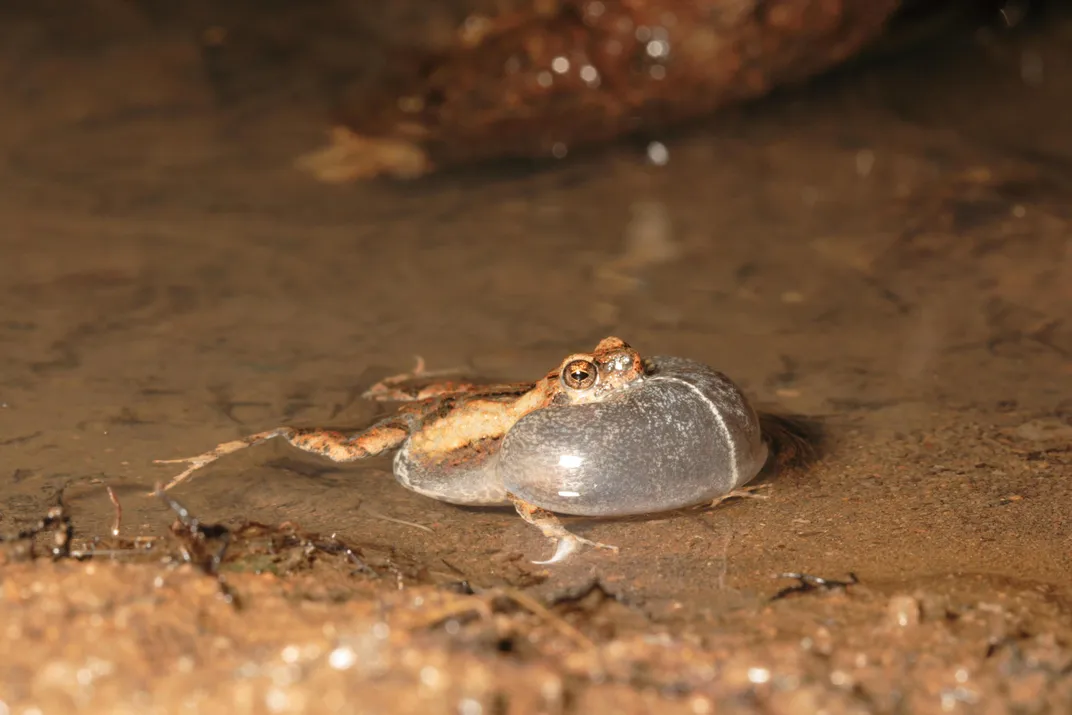Crazy Stupid Love: The Frog With a Mating Call That Also Attracts Predators
The sound and water ripples produced by the túngara frog’s mating call are picked up by predatory bats
:focal(500x495:501x496)/https://tf-cmsv2-smithsonianmag-media.s3.amazonaws.com/filer/11/ee/11ee7454-2ae3-4d61-8765-d1dee0b7941b/tungara_frog_3.jpg)
One of the most distinctive aspects of the túngara frog—a tiny amphibian native to Central America—is the strange call that males use to attract females as they sit in shallow ponds on the forest floor at night.
"They produce two kinds of calls—a simple one, and a complex one," says Rachel Page, a researcher at the Smithsonian Tropical Research Institute in Panama who's been studying the species for several years. "The basic one is this whining sound, and then they make it complex by adding these 'chuck' noises. A whine is necessary and sufficient to bring in a female, but chucks make the call more attractive."
The chucks are the equivalent of a peacock's plumage for a male frog in love—the way he convinces an alluring female to choose him, go off to a secluded spot to create a foam mating nest and starting making a family together.
But recently, Page and other STRI researchers discovered that these chucks also attract some unwanted attention. As they documented in a study published today in Science, the calls leave behind a physical trail of evidence in the water—a radiating circle of ripples—that a predatory bat species can detect with echolocation and use to lock on to its prey.
"The frogs call as conspicuously as they can to get mates," Page explains. "But in the course of calling, they're also making themselves vulnerable to predators, because bats can more easily localize calls with chucks."
The finding emerged through a project led by Wouter Halfwerk that looked at the acoustic and tactile effects of the frogs' calls on fringe-lipped bats, as well as on other frogs competing for mates. Wouter was inspired to study the topic, he says, after conversations with colleagues about other bat species' potential ability to detect fish breaching the surface of water by echolocation, which would allow the predators to know when to swoop in for the kill.
The male túngara frogs, he realized, similarly disturbed the surface of the shallow pools of water on the forest floor when they made calls. "The frogs have developed a big larynx to produce very low and loud sounds," says Wouter. "In addition, they possess a conspicuous vocal sac that's used to recycle air quickly for calling, and as air is shuttled back and forth into the vocal sac, the movement makes ripples on the water surface."
To test the hypothesis that the bats were picking up on these ripples, the researchers put fake plastic frogs next to shallow pools of water and played recordings of their mating calls. For some of the pools, they artificially generated ripples that resembled those made by calling frogs; others, they left still.
When they unleashed bats into the experiment, they found that they dove at the frogs next to rippling pools 36.5 percent more often than than the still ones. Interestingly, though, when they filled the pools with dead leaves—mimicking some natural forest pools, but also cutting off the movement of ripples—the bats' preference disappeared, indicating that in dirty pools, they can't track the ripples well enough to use them as a hunting cue.
Still, the ability to listen in on frog calls at all—both by hearing them and by detecting the ripples—is "very unusual," Page says. "This is the only species of bat in the world known to eavesdrop on the calls of frogs." Separate research has shown that the bat species is even capable of interpreting the sound of other frogs' calls to determine if it's a palatable or poisonous species.
The bats accomplish these feats, Page says, with a specially-adapted hearing system. Most bats are mainly sensitive to hearing their own echolocation calls, but this species has an additional sensitivity at a much lower frequency that matches the frog calls.
The frogs are clearly aware that, in some cases, their calls give them away. "When they see approaching bats, the first thing they do is stop calling," Page says. "Then they deflate their vocal sack, hunch lower into the water, and finally dive under the surface and swim away." Problematically, though, the rippling water can persist for a moment after they stop calling, a time lag that leads many an amorous frog to be eaten.
The researchers also found that competing frogs are keenly aware of the calls of adjacent males, due to both the sound and rippling generated. When they put frogs in an experimental pond and played other males' calls on a speaker, they found that the frogs got competetive—calling twice as frequently and adding more chucks to their calls—when the recorded calls were accompanied by artificial ripples, as compared to sound alone. A combination of noise and ripples, it seems, is necessary to set off a competetive instinct in the frogs' brains as they try to attract mates.
For Page, the research raises interesting questions about how bats in general perceive the world. So far, this is the only species known to eavesdrop on the calls of prey, but based on the way they detect both the sounds and water ripples generated by túngara frogs—and bats' remarkable ability to "see" their environment through echolocation—it's quite possible that other bat species are "seeing" more than we realize too.
"So far, this is the only type of bat we know of that can key in on frog calls this," she says. "But I just keep wondering whether there are more out there to be found."
/https://tf-cmsv2-smithsonianmag-media.s3.amazonaws.com/accounts/headshot/joseph-stromberg-240.jpg)

/https://tf-cmsv2-smithsonianmag-media.s3.amazonaws.com/filer/94/d7/94d7cbcc-3942-4c16-b263-1cce947dfeb8/tungara_frog_4.jpg)
/https://tf-cmsv2-smithsonianmag-media.s3.amazonaws.com/accounts/headshot/joseph-stromberg-240.jpg)